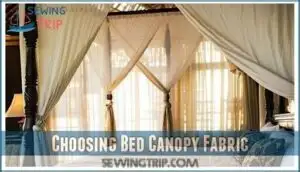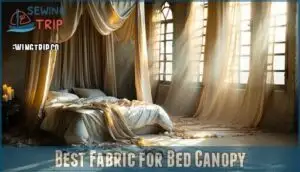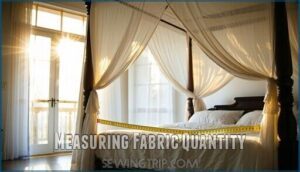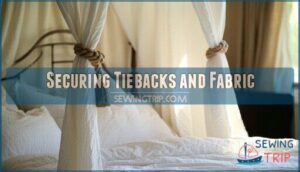This site is supported by our readers. We may earn a commission, at no cost to you, if you purchase through links.

For a light, dreamy look, go with sheer materials like chiffon or voile—they’re soft, airy, and let light filter through beautifully.
If you’re after coziness or drama, consider velvet or thicker cotton blends—they’ll add weight and a luxurious feel.
Muslin or linen works great for a casual, natural vibe.
Make sure to measure generously for draping, factor in tiebacks, and match the fabric to your room’s aesthetic.
A word of wisdom: lightweight fabrics are easier to hang and care for.
Curious about no-drill hanging options? Keep reading!
Table Of Contents
- Key Takeaways
- Choosing Bed Canopy Fabric
- Best Fabric for Bed Canopy
- Measuring Fabric Quantity
- Installing Bed Canopy Fabric
- DIY Canopy Installation Tips
- Bed Canopy Styles and Structures
- Fabric Selection for Bed Canopy
- Hanging Bed Canopy Without Drill
- Bed Canopy Fabric Requirements
- Creating a Custom Bed Canopy
- Frequently Asked Questions (FAQs)
- Conclusion
Key Takeaways
- Choose lightweight fabrics like chiffon or voile for a dreamy, airy vibe, or go for velvet or silk to add luxury and drama.
- Measure generously for proper draping and tiebacks, ensuring there’s enough fabric for a balanced and polished look.
- Match the fabric’s style, texture, and color to your room’s decor to create a cohesive and inviting atmosphere.
- Use no-drill hanging options like command hooks or hoops for an easy, damage-free installation.
Choosing Bed Canopy Fabric
Picking the right fabric for your bed canopy is all about balancing style, comfort, and practicality.
Whether you’re drawn to luxurious silk or lightweight muslin, the material you choose should complement your room’s décor and suit your personal preferences.
Silk and Velvet Options
Silk drape and velvet texture are timeless choices for bed canopy fabric, bringing an elegant aesthetic to any room.
Silk and velvet redefine luxury, transforming bed canopies into timeless statements of elegance and cozy sophistication.
Silk offers a soft sheen, while velvet adds depth and richness, perfect for luxurious canopies.
Mixing these luxury canopy fabrics creates stunning fabric combinations, whether you prefer silk’s lightness or velvet’s warmth, both elevate canopy draping fabric to pure sophistication.
Muslin and Chintz Alternatives
If silk feels too formal, muslin and chintz make excellent lightweight canopy fabric options.
Muslin’s breathable texture is perfect for airy designs, while chintz adds charm with colorful patterns.
Looking for creative alternatives? Try gingham canopies for a playful vibe or tapestry options for a bold statement.
Mixing these unique fabrics creates stunning combinations that fit any style.
Considering Room Decor
When picking fabric for your bed canopy, match it to your bedroom decor for a cohesive look.
Consider these five tips:
- Align the fabric’s color palette with your walls and bedding.
- Prioritize texture harmony for a balanced feel.
- Maintain style consistency with existing furniture.
- Use lighter fabrics to enhance lighting effects.
- Verify furniture integration for seamless room ambiance.
Best Fabric for Bed Canopy
When choosing the best canopy fabric, think about its weight, fiber content, and drape quality.
Lightweight fabrics like voile or muslin create a breathable canopy, perfect for summer, while velvet or silk add warmth and luxury in cooler seasons.
Consider light diffusion—sheer materials offer a dreamy glow, while heavier ones provide privacy.
Here’s a quick guide:
| Fabric Type | Best For | Key Feature |
|---|---|---|
| Silk | Elegance, warmth | Luxurious sheen |
| Muslin | Casual, airy feel | Lightweight texture |
| Velvet | Cozy, dramatic look | Rich depth |
Your canopy fabric should match your room’s vibe while standing out beautifully, with a focus on elegance and luxury.
Measuring Fabric Quantity
Measuring fabric for your bed canopy might seem tricky, but it’s easier than you think with a few simple steps.
You’ll need to account for the canopy’s size, tiebacks, and any extra fabric for that perfect drape.
Calculating Fabric Length
To calculate bed canopy fabric length, measure the frame dimensions, then use the standard equation: multiply the width by four and add extra for tieback allowance and puddling options.
Don’t forget seam considerations and fabric width when estimating fabric yardage.
For example, wider fabrics reduce seams, while extra length guarantees your canopy fabric drapes beautifully without looking skimpy.
Shoppers often look for the ideal fabric dimensions to suit their needs, considering the ideal fabric dimensions is crucial.
Accounting for Tiebacks
When planning tiebacks for your bed canopy, remember to add extra fabric to your measurements.
Tieback length depends on style integration and placement options, so consider a functional design that complements your fabric selection.
Matching tiebacks with your chosen fabric types and lining creates a cohesive look, blending seamlessly into the room’s aesthetic while keeping your canopy practical and elegant.
Budgeting for Fabric Costs
Set a clear budget to avoid project overspending.
Fabric affordability depends on canopy fabric material; cotton blends work well for tight budgets.
Sewing complexity also affects cost—simple designs save money.
Hunt discounts at fabric stores or online, and consider alternative materials like upcycled fabric.
Affordable canopy fabric transforms spaces beautifully without breaking the bank, blending style and savings effortlessly, and staying within a clear budget.
Installing Bed Canopy Fabric
Installing a bed canopy fabric is simpler than you might think, as long as you’ve got the right tools and a clear plan.
From attaching loops to the ceiling to adding decorative touches, you’ll create a cozy, elegant space in no time.
Attaching Loops to Ceiling
To attach loops for your DIY bed canopy, consider your ceiling material first.
For drywall, use strong hooks rated for your canopy fabric material’s weight. Adjust cord length for proper height, and secure with sturdy knot types like slipknots for easy tweaks.
Sticky hooks work well for lightweight hanging methods. Consider using appropriate canopy hardware for secure installation.
Distribute weight evenly to avoid sagging or damage.
Hanging Curtains From Loops
Once your loops are attached, thread your fabric options through them carefully.
Adjust the cord lengths for proper weight distribution, ensuring the bed canopy hangs evenly.
Use secure knots to keep everything in place.
Lightweight curtains work best for easy hanging methods, but heavier materials need sturdier loop material.
Experiment with slight draping for a cozy, inviting look.
Adding Decorative Elements
Adding decorative elements brings your canopy to life.
Small details make a big difference:
- Fringe Benefits: Add fringe or ribbon trim for texture.
- Trim Details: Use cording or borders to frame fabrics.
- Lighting Effects: String fairy lights for a dreamy glow.
- Fabric Strands: Drape extra material for softness.
- Personal Touches: Incorporate colors or patterns matching your style.
It’s all in the details!
DIY Canopy Installation Tips
You don’t need fancy tools to set up a stunning canopy; a few household items like hula hoops or plywood can do the trick.
Just focus on securing the fabric and tiebacks properly to guarantee everything stays in place and looks polished.
Using Hula Hoops or Plywood
Thinking creatively, hula hoops or plywood arcs can make sturdy DIY bed canopy bases.
Choose a hoop size that fits your bed’s dimensions, ensuring stability. Attach fabric securely with clips or sewing, keeping weight limits in mind.
You can even find a pre-made hoop canopy for easier installation. Plywood offers more support for heavier fabric types.
Both options add charm and practicality, making your canopy project simple yet stylish.
Securing Tiebacks and Fabric
Once your canopy base is ready, focus on securing tiebacks and fabric for a snug, stylish look.
Proper tieback placement keeps fabric panels neatly draped, balancing fabric weight. Use strong knots or hardware options like hooks for knot strength and secure draping.
- Choose sturdy tiebacks matching your curtains.
- Test fabric weight before finalizing placement.
- Opt for adjustable hardware for flexibility.
Ensuring Proper Construction
Strong construction keeps your DIY canopy safe and stylish. Focus on secure attachment and weight distribution.
Use reinforcement techniques like anchors or studs for heavier canopy fabric types. Match material compatibility with your setup.
Here’s a quick guide:
| Task | Tip |
|---|---|
| Anchor Placement | Attach to ceiling studs. |
| Weight Distribution | Balance fabric evenly. |
| Reinforcement | Use sturdy hardware. |
| Material Choice | Pick lightweight fabrics. |
| Safety Check | Test for stability. |
Stay secure, sleep soundly!
Bed Canopy Styles and Structures
You’ve got plenty of options in the area of bed canopy styles, from airy corner designs to dramatic crown canopies.
Each structure offers a unique way to frame your bed, adding both function and flair to your space.
Corner Canopies and Curtain Rods
Corner canopies are perfect for creating an open, airy feel in your bedroom.
Curtain rods, made from sturdy materials like wood or metal, offer reliable support for various canopy fabric types.
Lighter fabrics enhance airflow design, while heavier ones provide privacy.
- Use lightweight fabrics for breathability.
- Choose rods matching your room’s style.
- Make certain fabric weight suits rod materials.
- Position rods for balanced corner placement.
- Experiment with sheer fabrics for soft light diffusion.
Corner placement promotes light diffusion and a cozy vibe.
Crown Canopies and Half-Circles
Crown canopies create a regal touch, using half-circles made from plywood arcs for their striking shape.
Mounting techniques involve securing the arcs to the wall or ceiling, ensuring stability.
Pair sheer canopy fabric with soft lighting options for a dreamy effect. A thoughtful fabric choice integrates seamlessly into your bed canopy design, offering elegance without overwhelming the room’s aesthetic, creating a sense of elegance.
Single Ring Canopies and Headboard Rails
A single ring canopy adds charm and simplicity to your bed setup.
Attach the ring to your headboard railings, ensuring it suits your headboard style and rail materials.
Opt for lightweight, sheer canopy fabric for easy draping.
Secure the fabric with proper hanging methods, and consider your fabric choice carefully—durable yet elegant options work best for this DIY approach.
Fabric Selection for Bed Canopy
Choosing the right fabric for your bed canopy is all about balancing style, function, and personal taste.
Whether you prefer lightweight sheers for an airy feel or heavier materials for added privacy, there’s a fabric to match your vision.
Natural and Synthetic Fibers
Choosing between natural and synthetic fibers for your bed canopy depends on your priorities.
Natural fibers like cotton or linen offer breathability and comfort, while synthetic options like polyester provide durability and affordability.
Consider fabric blends for the best of both worlds.
Ethical sourcing and environmental impact are also worth thinking about when selecting materials for a cozy, stylish canopy.
- Natural fibers: breathable, eco-friendly, and soft.
- Synthetic fibers: durable, stain-resistant, and budget-friendly.
- Fabric blends: combine comfort with resilience.
- Weave types: influence texture and appearance.
Lightweight and Heavyweight Options
Lightweight fabrics like cotton, voile, or linen offer an airy drape, perfect for summer canopies.
Lightweight fabrics like voile or linen bring an airy, breezy charm, making summer canopies feel effortlessly magical and inviting.
Sheer canvas gives a breezy charm with a visual impact that’s hard to miss.
Heavier options, like velvet, add warmth and weight, ideal for cooler seasons.
Mixing seasonal fabrics or layering curtains creates stunning versatility, ensuring your bed canopy feels both cozy and practical year-round.
Sheer and Opaque Fabrics
Sheer fabrics like voile or chiffon create light diffusion, adding an airy, romantic vibe to your bed canopy.
They’re perfect for coziness without blocking natural light.
For more privacy, opaque options like velvet or brocade offer greater fabric weight and visual texture.
Layering effects with sheer curtains and heavier fabrics can balance privacy levels while keeping the design soft and inviting.
Hanging Bed Canopy Without Drill
You don’t need a drill to hang a stunning bed canopy—just a bit of creativity and the right tools.
With options like command hooks, sticky hooks, or embroidery hoops, you can create a dreamy setup without damaging your walls or ceiling.
Using Command Hooks and Sticky Hooks
Command hooks make bed canopy installation a breeze, especially for DIY setups.
Start with surface preparation—clean the ceiling for a strong hold. Check hook weight limits to match your fabric’s weight.
Hook placement should align with the bed frame, 12-18 inches from head and foot. For heavier fabric, consider alternative adhesives to prevent sagging.
It’s secure and headache-free, making the installation process efficient with the right preparation.
Attaching Fabric to Embroidery Hoops
Using an embroidery hoop to hang your bed canopy is simple and budget-friendly.
Choose a hoop size that suits your space, then secure fabric by wrapping it tightly to guarantee proper tension.
Add decorative trims for a polished look, and use lightweight fabric to prevent sagging.
Hang it with sturdy methods like hooks or strong cords for stability in your DIY project.
Creating a No-Drill Canopy Frame
For a no-drill bed canopy frame, try these budget-friendly ideas:
- Use adhesive options like Command hooks to secure lightweight materials.
- Set up tension systems with curtain rods for dorm bed canopy use.
- Explore frame alternatives, such as embroidery hoops, for extra stability.
These no-drill options guarantee stability without damaging walls, perfect for renters or small spaces!
Bed Canopy Fabric Requirements
Choosing the right fabric for a bed canopy requires accurate measurements, extra material for tiebacks, and budgeting for fabric costs.
Whether you’re after something light and airy or rich and dramatic, you’ll need to plan carefully to guarantee your canopy looks great and fits perfectly.
Calculating Total Fabric Needed
Calculating the fabric for a bed canopy isn’t intimidating—just measure precisely.
Factor in fabric width, seam allowance, and canopy fabric weight.
Don’t forget a puddling allowance for elegance and pattern matching to avoid waste.
| Dimension | Formula | Added Tips |
|---|---|---|
| Length Needed | (Length x 2) + Bed Width | Add 12" for adjustments. |
| Tieback Fabric | (Fabric Height x 4) | Include extra for lining. |
| Total Yardage | Total Inches ÷ 36 | Round up, avoid shortages. |
To ensure accurate calculations, consider the total yardage needed and the importance of seam allowance in your measurements.
This will help you plan the project effectively and make necessary adjustments without running into shortages.
Adding Extra Fabric for Tiebacks
Don’t skimp on fabric when adding tiebacks for your bed canopy.
Extra length guarantees flexibility for securing fabric panels or adjusting curtains neatly. Follow a Tieback Length Guide to determine what works; longer tiebacks suit draped styles, while shorter ones are elegant for crisp looks.
For DIY enthusiasts, braid lining or experiment with creative Tieback Style Options for unique placement ideas.
Considering Fabric Costs and Sewing Techniques
When you’re planning your fabric budgeting, factor in sewing difficulty and potential alteration costs.
A simpler fabric might save DIY project time, but heavier materials need advanced sewing techniques.
Consider the cost-benefit analysis: pricier fabric may mean fewer repairs later.
DIY savings often stem from smart planning, so pick fabrics that suit your sewing skills and align with your canopy vision.
Creating a Custom Bed Canopy
You can design a custom bed canopy by mixing fabrics, colors, and textures to match your style.
Add details like borders or fringe, and use tiebacks for a polished, cohesive look.
Mixing and Matching Fabrics and Colors
Mixing textures and patterns can bring your bed canopy to life.
Try layering sheer fabric panels with rich velvet for depth.
Coordinate colors within your favorite palette, or go bold with pattern clashing—think stripes paired with florals.
Seasonal fabrics like lightweight cotton for summer or cozy wool in winter let you express personal style while keeping the design fresh and inviting.
Adding Borders, Fringe, and Tie-Backs
Fringe styles add texture and charm; use tassels or cords as trim accents for visual depth.
Border materials like lace or embroidered fabric elevate elegance, tying together the design.
Tieback placement matters—secure fabric panels neatly while accent colors enhance cohesion.
Mixing fringe, borders, and tiebacks creates personality, turning your canopy into a cozy, stylish retreat.
Ensuring a Polished and Integrated Look
How do you guarantee your bed canopy looks polished and cohesive? Focus on consistent style and seamless integration by using matching hardware and coordinating colors.
Hidden seams and lined fabric panels elevate the design, while cohesive details like ties or trim unify the look.
Explore canopy fabric ideas that balance elegance and practicality, creating a design that feels complete and inviting, with a focus on seamless integration.
Frequently Asked Questions (FAQs)
What Other Materials Can Be Used to Make a Bed Canopy?
Did you know lightweight materials like netting, chiffon, and nylon make dreamy bed canopies?
You can also get creative with upcycled fabrics, parachute silk, or even sheer curtains for a stylish, airy look.
How Can I Make a Canopy Bed Without Wood?
Use hula hoops, curtain rods, or embroidery hoops as a base for your canopy.
Secure lightweight fabrics with adhesive hooks or clips, then drape and adjust for balance.
Add fairy lights for extra charm!
What is the Best Way to Hang a Bed Canopy?
Hanging a bed canopy is simpler than rocket science!
Anchor sturdy hooks to your ceiling beams or studded walls.
Thread lightweight fabric through rings or hoops, and let it drape elegantly—romantic vibes guaranteed.
How Can I Customize a Bed Canopy to Fit My Specific Theme?
Customize your bed canopy by matching fabrics to your theme—think velvet for luxury, sheer voile for romance, or bold prints for a playful vibe.
Add trim, fairy lights, or tiebacks to enhance the look!
What Types of Trims Can Be Used to Decorate a Bed Canopy?
Think of trims as the jewelry for your bed canopy—options include tassels, fringe, lace, cording, beads, or embroidered ribbons.
They add texture, elegance, and personality while complementing your room’s style and theme beautifully.
What material to use for a bed canopy?
Lightweight cotton or sheer fabric like chiffon creates an airy, dreamy vibe.
Match your style and function—durable nylon works too, especially for kids’ playful canopies, while rich velvet or silk adds drama and elegance.
What kind of fabric is used for canopies?
A canopy’s fabric is its soul; choose silk, velvet, or voile for elegance, muslin or linen for a breezy feel, and sheer chiffon for romance.
Match your room’s vibe, and don’t skip lining for durability!
What is the best material to make a canopy out of?
The best material for a canopy depends on your vibe.
For elegance, go with silk or velvet.
For something light and airy, chiffon or muslin works wonders.
Want durability? Consider cotton blends or sheer nylon!
What other materials can be used to make a bed canopy?
You can use materials like chiffon, nylon, voile, or parachute silk for a lightweight, dreamy vibe.
For a rustic or dramatic look, try muslin, canvas, or tapestry.
Even upcycled fabrics work beautifully!
How can I make a canopy bed without wood?
Think outside the wooden box—try curtain rods, command hooks, or a sturdy hula hoop.
Suspend lightweight fabrics like voile or chiffon from the ceiling, adding fairy lights or ribbons for a dreamy, no-wood canopy.
Conclusion
Transforming your bed into a dreamy retreat starts with the right fabric choice.
Whether you’re opting for sheer chiffon for airy elegance, cozy velvet for drama, or linen for a casual, natural vibe, your canopy reflects your style.
Don’t forget to measure generously for draping and tiebacks, and match the material to your room’s aesthetic.
If you’re wondering what kind of fabric for bed canopy how to create one, remember, lightweight options are the easiest to install and maintain, and this will help you with happy decorating, and choosing the right fabric is key to a dreamy retreat.




















